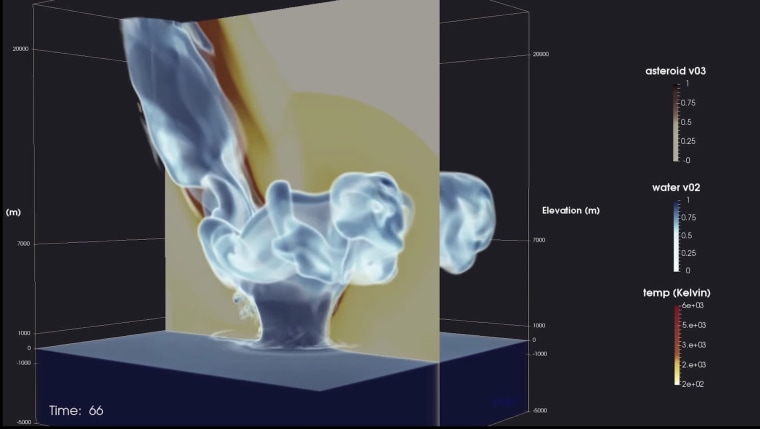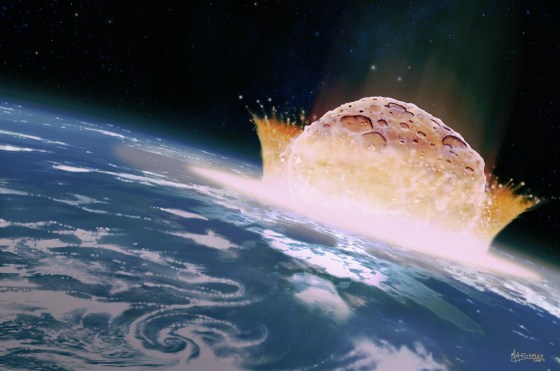When an asteroid hits the middle of the ocean in Hollywood movies, it creates devastating waves that wipe out coastal cities. But new simulations reveal that real asteroids don't make such a splash. That's because the crash releases most of its energy hurling water up into the atmosphere, and very little on making waves.
"The folklore has been that tsunamis from impactors will be the danger," Galen Gisler, who studies the physics of geological processes at Los Alamos National Laboratory, said at the Lunar and Planetary Sciences Conference last month in The Woodlands, Texas. (Gisler also presented the work at the American Geophysical Union's fall meeting in December 2016.) He ran 3D simulations that modeled wave formation from falling rocks of various sizes, as shown in this video, and found that the waves formed by smaller asteroids resemble landslide tsunamis on Earth.
"The splash wave can be very dangerous — out to tens of kilometers — but beyond that, they fall away more sharply," he said.
Splashdown
Earth doesn't drift alone in its orbit. Hundreds of thousands of near-Earth objects (NEOs) dance near its path, most of them rocky material born from ancient asteroid collisions. Once every 10,000 years or so, objects larger than 328 feet (100 meters) are expected to crash into the planet, with potentially devastating effects, according to NASA's Jet Propulsion Laboratory (JPL). With approximately 70 percent of Earth's surface covered with water, the oceans are the most likely landing spots for incoming asteroids.
Asked by NASA to calculate the smallest asteroids that should generate concern, Gisler ran 3D simulations to study the possible effects from an ocean splashdown. Such studies are time-intensive because they require modeling millions of particles, Gisler said; the 11 simulations he ran took him several months. He focused on asteroids with diameters under a third of a mile (500 meters).
Related: 5 Reasons to Care About Asteroids
Such detailed models are necessary to study the possible effects of the asymmetries that arise from an impact, he said. While asteroids can drop straight down into the ocean, they are far more likely to approach the water at an angle. The resulting impact will push more water in front of it than behind, and Gisler wanted to understand how this would affect any wave formation, like a potential tsunami.
It turns out asteroids are terrible at making waves. Gisler found that most of the energy (80 percent) from an impact is spent vaporizing water and forming a crater. The remaining 20 percent throws most of the liquid water up into the atmosphere, where it has the potential to affect weather patterns, he said. He estimated that only a tenth of 1 percent of the kinetic energy from an impact is spent forming waves. Those waves can still be massive, but they break up quickly.

Gisler found that asteroids approximately 460 feet (140 meters) in size and larger are most likely to cause significant problems. Today, NASA's Center for Near Earth Object Studies is working to identify 90 percent of the NEOs this size and larger, according to JPL; so far, they've spotted just over half of the estimated population.
If the asteroid impact is within 60 miles (100 km) or so of the shore, it can dramatically impact the coast, Gisler said. Larger objects, around 980 feet (300 meters), can create hurricane-force winds and shock waves in the air, as well as localized waves. But if the asteroid splashes down farther from the coast, the massive waves it forms quickly break in the open ocean.
Related: NASA's Bold Plan to Save Earth From Killer Asteroids
"It's very ineffective at actually producing a wave," Gisler said. "The waves don't propagate very well."
In fact, the effect is similar to waves produced by landslides around fjords in Norway and Iceland, he said. When material slides down the mountains and into these long, narrow inlets, they can create massive waves that have a large local effect but don't spread very far. In 1934, one such avalanche dropped enough rock to form waves 203 feet (62 meters) high, destroying several inhabited villages. While these landslides can be devastating for those near them, they pose little danger for those some distance away, Gisler said.
Thus, asteroid impact near the shore can wreak havoc, but the limited reach of those farther out in the ocean should cause far less concern.
"If you're more than 100 kilometers from a shoreline, I would be tempted to say let the thing drop and study it," Gisler said.
Follow Nola Taylor Redd at @NolaTRedd, Facebook, or Google+. Follow us at @Spacedotcom, Facebook,or Google+. Originally published on Space.com.
EDITOR'S RECOMMENDATIONS
